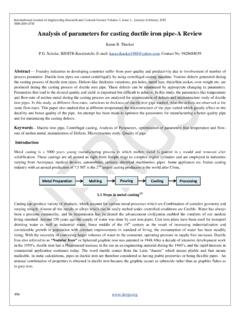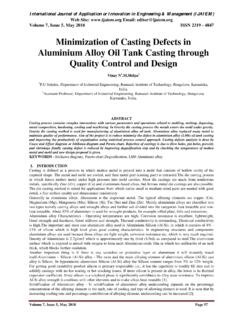Transcription of Analysis to Approach Minimization of Defects in …
1 International Conference On Emanations in Modern Technology and Engineering (ICEMTE-2017) ISSN: 2321-8169 Volume: 5 Issue: 3 93 - 97 _____ 93 IJRITCC | March 2017, Available @ (Conference Issue) _____ Analysis to Approach Minimization of Defects in Small Scale Foundry Industry GovindNarayan Singh 2nd Year Production Engg Department of Mechanical Engineering Government College of Engineering, 444604 [ ] India Email: Dr. A. G. Matani Associate Professor Department of Mechanical Engineering Government College of Engineering, Amravati - Amravati - 444604 [ ] - India Email: Abstract- casting is the process which used in foundry industry and it is impossible to make a defect free casting but the regular efforts have been made by the company for the Minimization of the Defects like shrinkage defect ,sand inclusion etc.
2 Main issues with the defect of the casting is that there is number of reason behind defect formation in casting so in this research paper an Approach has been made so to identify the main Defects which forms and there root causes with reasons behind it on the basis of the data taken from the foundry industry and then we will make use suitable method which will help in Minimization of percentage of the defect in the foundry industry. Keywords- casting , casting Defects , shrinkage, sand inclusion, foundry industry etc. _____**_____I. INTRODUCTION casting is the process which started very long ago 3000 BC for the making of the is very complicated process so for doing it in a efficient way one should be closely monitoring the process while it have been taken otherwise will lead to pure loss. In the process of casting the main thing which we have to take care of the things which have involve in this process and have the main concern to achieve the zero defect of the casting product so for that one have the knowledge of the parameters and the main influence which effect the product and which have been responsible for the Defects in the products mainly industries were making so much effort forthe Minimization of the defect in their product so that the loss and the amount of rejection in their finished product have been reduced and so for that one have to search and find the main root causes of the Defects which have been most common and try to resolve it.
3 The main defect which have been found in the foundry industries are as follows- 1. Shrinkage defect 2. Blow hole 3. Sand burning 4. sand inclusion 5. Mis-run 6. Gas porosity 7. Cold lap 1) Shrinkage Defect Shrinkagedefect occurs when the availability of molten metal is less to compensate the shrinkage. It is the most common defect which have been found in mostly foundry industries. Shrinkage defect has been classified into two types :- 1) Open shrinkage defect It is open to the atmosphere so the open cavity have been compensate Two types of open shrinkage pipe and carved Pipes form at the surface of the casting and burrow into the casting , while caved surfaces are shallow cavities that form across the surface of the casting . 2) Closed shrinkage It is also known as the shrinkage porosity it have been formed Isolated pools of liquid form inside solidified metal, which are called hot spots.
4 The shrinkage defect usually forms at the top of the hot spots. They require a nucleation point, so impurities and dissolved gas can induce closed shrinkage Defects . International Conference On Emanations in Modern Technology and Engineering (ICEMTE-2017) ISSN: 2321-8169 Volume: 5 Issue: 3 93 - 97 _____ 94 IJRITCC | March 2017, Available @ (Conference Issue) _____ Shrinkage defect 2) Blow Hole Blow hole is a type of a cavity defect. Gases entrapped by solidifying metal on the surface of the casting , which results in a rounded or oval blowhole as a cavity. Frequently associated with slags or oxides The Defects are nearly always located in the cope part of the mould in poorly vented pockets and undercuts.
5 It is classified into two types :- 1) Pin hole-it is tiny holes. 2) Sub surface blow hole- it is holes on the surface which can be seen only by machine Figure 2 :- Blow Holes 3) Sand burning It is also called burning on effect. Itcan happen when sand is subjected to high temperature causes sintering of the Bentonite and silicate components. In addition, the always present iron oxides combinewith the low-melting-point silicates to form iron silicates, thereby further reducing the sinter point of the and melting of the impurities in the moulding sand enable the molten iron to penetrate even faster,these layers then frequently and firmly adhering to the casting surface. Sand burning 4) Sand inclusion It is the defect which have been formed because the sand close to the casting surface combines with protuberance at other point.
6 It is one of the major defect found in the casting and the chances of the inclusion of the sand has been too much if there is any fault on the process of the casting and it also known as scab or a blacking scab. Fig. 4 Sand inclusion 5) Misrun It have been the defect of the incompletion of the metal when the the molten metal has been nt able to fill the cavity into the proper amount so this has been happen it is known as mis run. Misrun International Conference On Emanations in Modern Technology and Engineering (ICEMTE-2017) ISSN: 2321-8169 Volume: 5 Issue: 3 93 - 97 _____ 95 IJRITCC | March 2017, Available @ (Conference Issue) _____ 6) Gas porosity- Gas has been trap into the cavity hydrogen dissolved in aluminum alloys, moisture from waterbased die lubricants or steam from cracked cooling lines.
7 Present air in the cavity before the shot. It caneasily be trapped as the metal starts to fill the cavity. then the air compressed as more and more metalstreams into the cavity and rises the pressure. When the cavity is full it becomes dispersed as small spheres ofhigh pressure air. The swirling flow can cause them to become elongated. 7) Cold lap It is a crack with round edges it occurs mainlybecause gating system is poor and the melting temperature is low. It is also called cold shunt it also been happen when the two metal do not fuse properly and streams. Cold Lap Analysis In this Analysis we have to close monitoring on the industry and take the reading of the production Defects and the amount of the rework rejection in the form of the scrap and the riser so it can be used after doing machining on it and these data has been collected.
8 MONTH SHRINKAGE BLOW HOLE SAND INCLUSION SAND BURNING MISRUN GAS POROSITY COLD LAP 1 31 17 21 8 5 15 8 2 28 15 16 11 5 16 9 3 29 14 13 10 8 15 10 4 27 13 20 10 5 18 7 5 29 16 15 7 9 19 5 6 32 13 14 11 9 12 9 Fig Line chart International Conference On Emanations in Modern Technology and Engineering (ICEMTE-2017) ISSN: 2321-8169 Volume: 5 Issue: 3 93 - 97 _____ 96 IJRITCC | March 2017, Available @ (Conference Issue) _____ Defect percentage on the production So the purely rejected metal and the scrap metal was observed and the following observations were obtained. The Defects were distributed according to their percentage in below :- Fig:- Representing the percentage of various Defects 02004006008001000120014001600month 1month 2month 3month 4month 5month 6productionrejection scrapzero defect0102030405060708090100 MONTH 1 MONTH 2 MONTH 3 MONTH 4 MONTYH 5 MONTH 6 COLD LAPGAS POROSITYMISRUNSAND BURNINGSAND INCLUSIONBLOW HOLESHRINKAGEI nternational Conference On Emanations in Modern Technology and Engineering (ICEMTE-2017) ISSN: 2321-8169 Volume: 5 Issue: 3 93 - 97 _____ 97 IJRITCC | March 2017, Available @ (Conference Issue) _____ Conclusion This research paper observes the impact of the casting Defects in the foundry industry.
9 These Defects were in large occurrences and should have to reduced. So in this paper we observed that the amount of the defect due to which pure rejection and scrap (rework needed) minimum about 2% and 15 % respectively on which the percentage of the Defects like shrinkage, gas porosity, misrun, sand inclusion, sand burning, blow hole, cold lap. These are the main Defects which we obtained out of these shrinkage sand inclusion and gas porosity have been found in the more amount as compare to the others for that we the reason behind these percentage of moisture, nature of sand, temperature, size of mould, location feeder and sufficiency of molten metal we work on this and modify according to need so that defect have minimized to its optimum level and loss in the industries reduced.
10 REFERENCES [1] K. Siekak. Sieka skiski, S. Borkowski, Analysis of foundry Defects and preventive activities for quality improvement of castings , METALURGIJA 42 ,ISSN 0543-5846, 2003 [2] Vijayaram, S. Sulaiman, A. M. S. Hamouda, Ahmad, Foundry quality control aspects and prospects to reduce scrap rework and rejection in metal casting manufacturing industries ,Journal of Materials Processing Technology, 178, 39-43, 2006 [3] B. N. RAO, Rajesh Ashokkumar, Effect of blow-holes on reliability of cast component , Sadhana Vol. 33, Part 6, 2008 [4] Dr Shivappa, Mr. Rohit, Mr. Abhijit Bhattacharya, Analysis of casting Defects and Identification of Remedial Measures A Diagnostic Study ,International Journal of Engineering Inventions , ISSN: 2278-7461, Volume 1, Issue 6 , PP: 01-05, 2012 [5] Achamyeleh A. Kassie, Samuel B.












